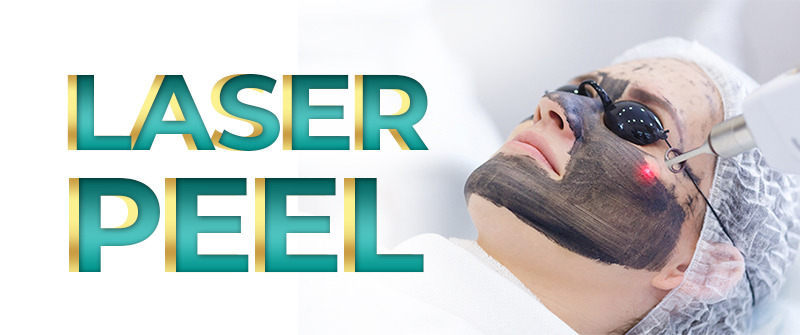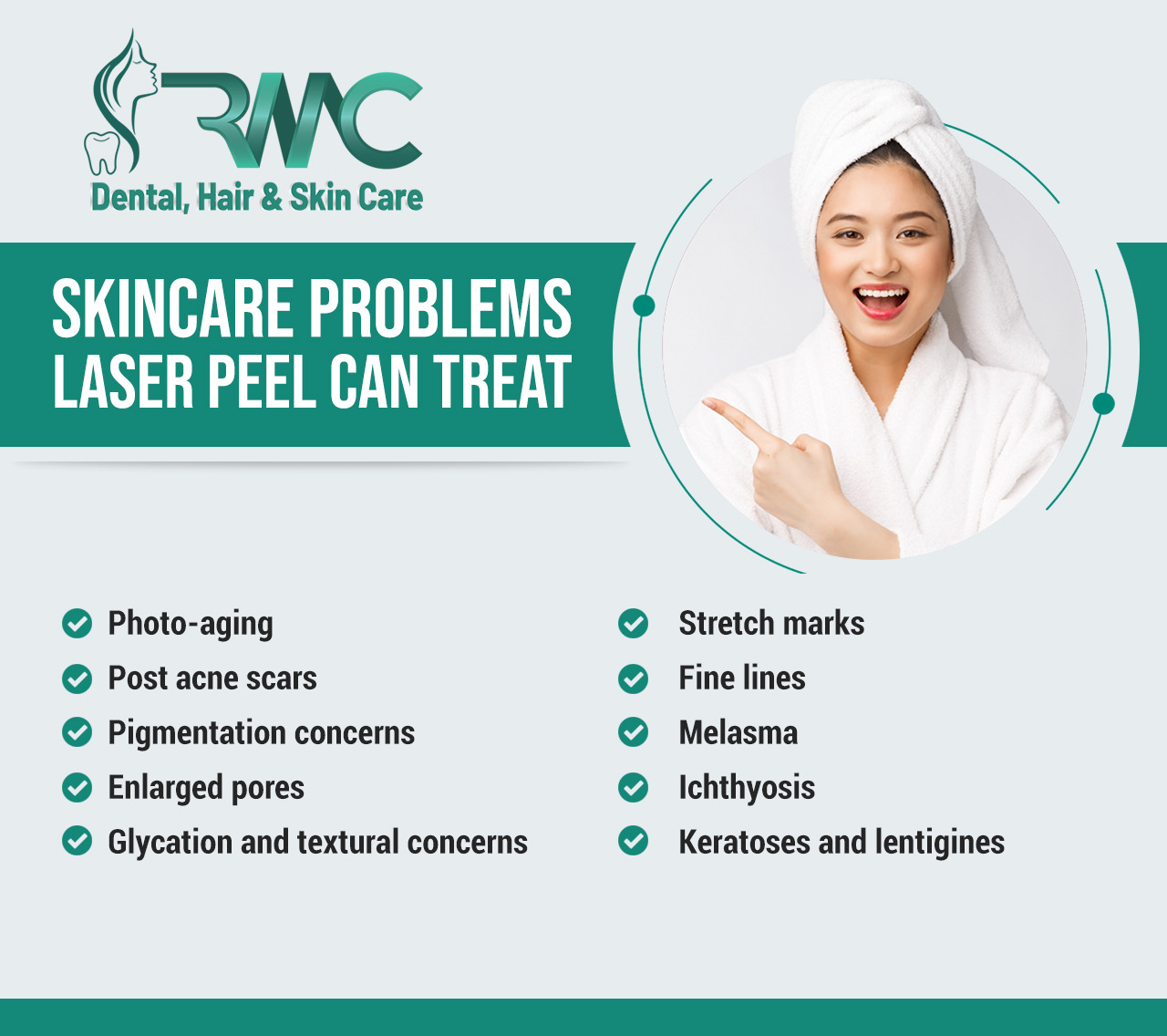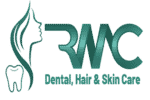
What is laser Peel Treatment?
A laser peel is a skin resurfacing treatment that helps reduce wrinkles, scars, and unwanted texture. This procedure is also known as laser ablation, laser resurfacing, and laser vaporization. This is done by exposing the affected area to short bursts of concentrated light that removes the damaged layers of skin.
Laser peel treatments, including peel Off, are innovative, minimally invasive, rejuvenating skin care procedures that reveal fresher, younger, healthier-looking skin. The power of these treatments is quite remarkable when you consider the many skin problems they address, including hard-to-treat acne and melasma.
What conditions can be treated?
- Photo-aging
- Post acne scars
- Pigmentation concerns
- Enlarged pores
- Glycation and textural concerns
- Stretch marks
- Fine lines
- Melasma
- Ichthyosis
- Keratoses and lentigines
Two Major Skin issues Melasma and Acne can be easily tackled by these treatments.
1. Melasma and Laser & Peel-Off Treatment
Melasma is a highly visible skin pigmentation concern that appears as brown or gray patches on the face. Occurring 90% of the time in women, melasma often appears during pregnancy, although men can also experience melasma.
2. Acne and Laser & Peel Off Treatment
Acne starts from oil glands under the skin attached to hair follicles. Bacteria begin to form when dead skin cells, toxins, or other debris clog pores. The oil glands become inflamed and the natural performance of the oils slows down, creating a comfortable habitat for further bacterial growth. Acne can be caused by many other factors such as stress, poor diet, hormonal changes, or certain medications.

What Treatments Can Help?
Rahman Medical Center provides safe and effective peel Off and laser treatments with the help of top doctors and dermatologists.
-
Peel Off
A peel Off is a facial treatment that works to improve the skin’s overall appearance and targets problems such as wrinkles, acne, blemishes, and uneven skin tone. It essentially exfoliates the top layers of the skin so it can grow more smoothly than before.
Peel Off is a very effective and proven treatment for melasma. Peels remove the top layer of skin, removing melasma and replacing it with fresh, glowing skin. When treating acne, this treatment is very effective due to the fact that the peels use a mild acid formula to remove toxins, damaged skin, dead skin cells, oils, and bacteria. A peel penetrates beneath the top layer of skin, closing the pores and ridding the body of acne-causing bacteria. A peel Off smoothes the skin’s texture, including acne scars, addressing pigmentation concerns like melasma and leaving a renewed, healthy layer of skin.
Pros of Peel Off
The peel is great for superficial blemishes and can benefit all skin types from fair to medium skin. However, Mattioli urges caution when using stronger ones on dark complexions that are more prone to post-inflammatory hyperpigmentation.
Cons of Peel Off
When it comes to recovery, it’s not a one-size-fits-all situation. “The in-office peel options are endless. Some don’t need downtime. One may feel a little redness and flaking, but that’s it” “There are hundreds of different lasers. While many offer a mild recovery with little or no recovery period, others can see a person pink and swollen for up to a week.
But again, this varies depending on the specific procedure. However, aftercare does not. Patients should avoid scrubs, cleansing brushes, washcloths, retinoids, acne medications, and alpha/beta hydroxy acids to avoid interfering with the healing process for about a week. In terms of topical, stick to a gentle cleanser with antibacterial support, a soothing moisturizer, a hydrating serum, and a broad-spectrum mineral sunscreen.
Types of Peel Off
Peel Off can be divided into three types depending on the depth of action.
- Superficial:
Superficial peels penetrate only the superficial layer of the skin, i.e., the epidermis. This method is used to treat conditions such as acne and melasma.
- Medium:
Medium-deep peels penetrate the papillary dermis. It is commonly used to treat superficial scars, pigmentary disorders, dyschromia, multiple solar keratoses, etc.
- Deep skins:
Deep peels penetrate the reticular dermis and can be used to treat deep wrinkles, scars, and severe photoaging.
Peel Off is often combined with other resurfacing techniques to optimize results. It should be noted that the degree of clinical changes is directly related to the depth of penetration. However, as the depth of penetration of the peeling agent increases, so does the healing time.
-
Laser Treatments
A laser peel is a treatment that uses a laser to remove the outer layers of skin and heat the skin underneath. This treatment is often used to help with deep wrinkles, acne scars, sun-damaged skin, and other deep-rooted skin concerns.
Laser treatments pass a beam of light over the top layers of the skin, which destroys and breaks up the pigmentation of melasma and acne scars. The laser’s energy penetrates beneath the skin to increase the production of collagen, which improves skin texture by stimulating the growth of new, healthy skin cells. Laser energy reaches deep into the skin to kill harmful, acne-causing bacteria and reduce oil production, improving existing acne and helping to prevent future breakouts.
Pros of Laser Treatment
If someone is looking for a treatment that targets deeper skin problems, laser treatment is the best option. “Wrinkles, pigments, and vascular problems require doctors to reach deep into the skin with the laser.” It’s also great for collagen regeneration and great for precision. For example, when using a laser to target acne scars or a few brown spots, it is possible to focus on them individually. “It produces faster results than peels, and there are color-blind models that can safely treat dark skin.”
Disadvantages of laser treatment
Laser treatments are not as gentle on your wallet as skins.
Laser resurfacing options
There are different laser options to choose from depending on your skin condition.
- CO2 laser:
CO2 laser is an ablative laser technology used to treat warts, skin blemishes, wrinkles, etc.
- Pulsed dye laser:
This type of laser resurfacing is used to reduce redness, broken capillaries, hyperpigmentation, rosacea, etc.
- Fractional laser:
In this technology, the laser energy is broken down into thousands of tiny beams that work on a very small area of skin. This procedure is used to treat age spots.
- Erbium laser:
This technique promotes collagen regeneration and is widely used for skin laxity, age spots, fine lines, wrinkles, etc.
-
Peel Off vs Laser Treatment
Overall, peel Off and lasers share virtually the same goal: to improve the overall appearance of the skin and erase imperfections. While these procedures address many of the same concerns, including discoloration, fine lines, and rough texture, that doesn’t mean they’re interchangeable.
Although both procedures provide permanent results, it depends on the problem being treated. The pigment can be tricky. Generally, one can have an even tone for months or years if one is careful with SPF and have a solid skincare routine.
The choice mainly comes down to which complexion one wants to eliminate. For some conditions, splurging on a laser is worth the money for stronger results, but for other concerns, a peel will definitely do the trick. When in doubt, seek the advice of a licensed dermatologist or esthetician.
Rehman Skin Care will help you out in highlighting your beauty. Rehman Skin Care is one of the best skin care consultants with a team comprises a team of expert medical specialists and doctors in Islamabad.
